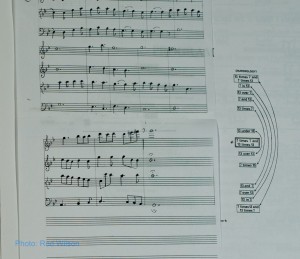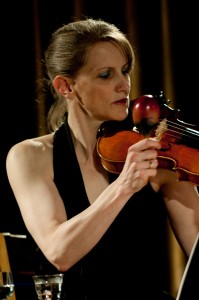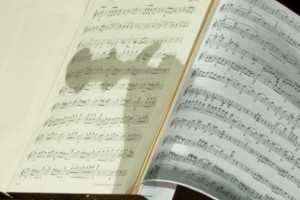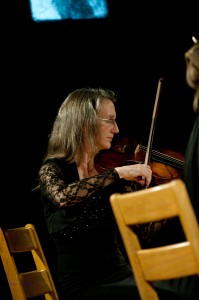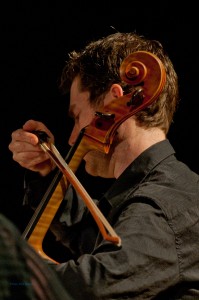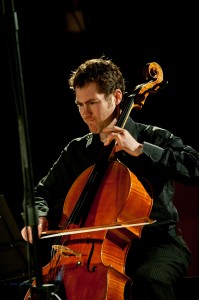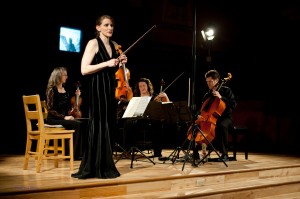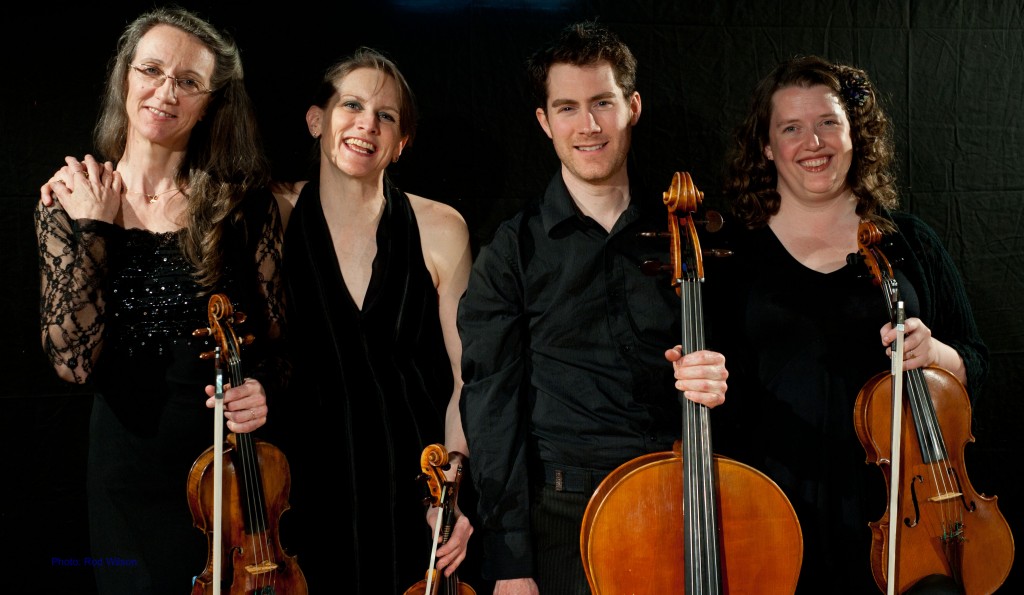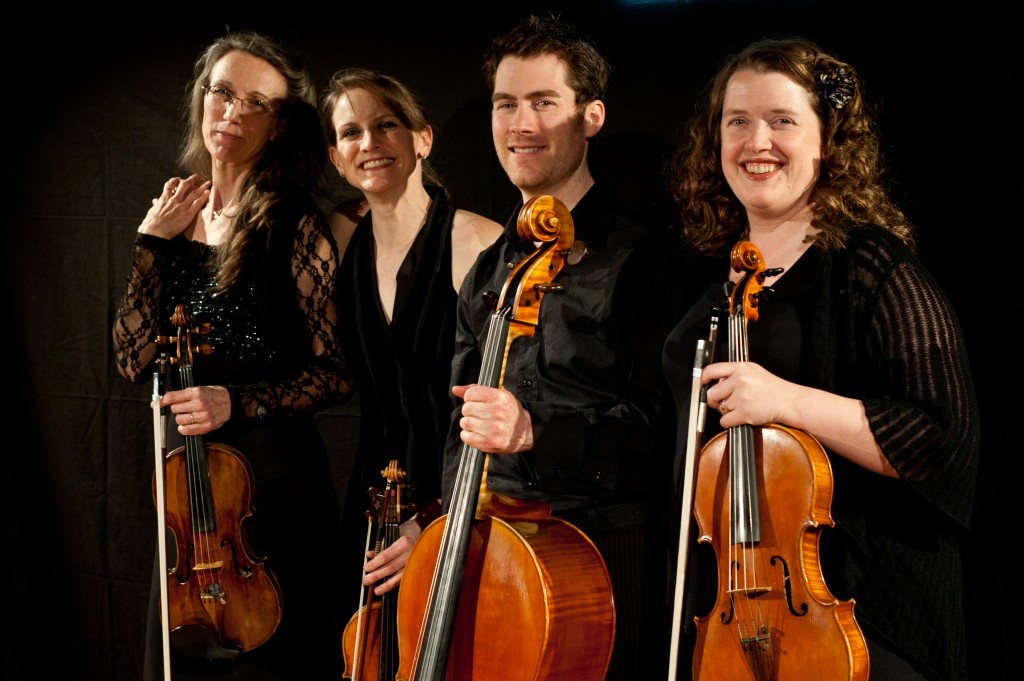La Cafamore String Quartet at the Knox Presbyterian Church,
April 20, 2013, 7:30pm
 Collectively musicians and their dedicated audiences are a conservative lot. It seems that the music we are introduced to between the ages of fifteen and thirty years becomes the sound track of our lives. If you are a baby boomer then the chances are that Classic Rock is your sound track. For those born a little later probably it will be Heavy Metal. Likewise musicians reflect what they have been exposed to either as a listener or as a journeyman while they are learning their craft. Jazz musician usually rattle around in the cage of be-bop or the immediate post bop schools of John Coltrane and Miles Davis. Classical musicians are completely embedded in the Romantic and post Romantic schools of music. So, I guess, it explains the popularity of Tribute Bands, the never ending revivals of the same
Collectively musicians and their dedicated audiences are a conservative lot. It seems that the music we are introduced to between the ages of fifteen and thirty years becomes the sound track of our lives. If you are a baby boomer then the chances are that Classic Rock is your sound track. For those born a little later probably it will be Heavy Metal. Likewise musicians reflect what they have been exposed to either as a listener or as a journeyman while they are learning their craft. Jazz musician usually rattle around in the cage of be-bop or the immediate post bop schools of John Coltrane and Miles Davis. Classical musicians are completely embedded in the Romantic and post Romantic schools of music. So, I guess, it explains the popularity of Tribute Bands, the never ending revivals of the same  popular musicals and the stagnation of the Classical Symphony Orchestra Repertoire. So it is like a breathe of fresh air when the local ensemble La Cafamore String Quartet (Carolyn Cameron, Angele Synde, Jeff Faragher, & Alexis Moore) attempts to blow the wax out of our ears with some pretty adventurous programming. They tour through the Kootenays every spring and fall and during each tour they bring to audiences music that is fresh and challenging. For me the high light of their program last spring was Steve Reich’s Different Trains. This spring they have tried to out do themselves with George Crumb’s “Black Angels” and Schubert’s String Quartet in D Minor – “Death and the Maiden”. On the surface this would seem to be sombre fare for an evening’s entertainment. And yet, by no stretch of the imagination was this program a “snoozer”. The stage with its black backdrop and the Black Angel motif set the atmosphere for the processional entrance of Gabriel’s Message (a Basque Christmas Carol). I am not sure how a cello player manages to master the art of holding and bowing his instrument while marching but, whatever the technique required, it did not appear to be a
popular musicals and the stagnation of the Classical Symphony Orchestra Repertoire. So it is like a breathe of fresh air when the local ensemble La Cafamore String Quartet (Carolyn Cameron, Angele Synde, Jeff Faragher, & Alexis Moore) attempts to blow the wax out of our ears with some pretty adventurous programming. They tour through the Kootenays every spring and fall and during each tour they bring to audiences music that is fresh and challenging. For me the high light of their program last spring was Steve Reich’s Different Trains. This spring they have tried to out do themselves with George Crumb’s “Black Angels” and Schubert’s String Quartet in D Minor – “Death and the Maiden”. On the surface this would seem to be sombre fare for an evening’s entertainment. And yet, by no stretch of the imagination was this program a “snoozer”. The stage with its black backdrop and the Black Angel motif set the atmosphere for the processional entrance of Gabriel’s Message (a Basque Christmas Carol). I am not sure how a cello player manages to master the art of holding and bowing his instrument while marching but, whatever the technique required, it did not appear to be a  great challenge for Jeff Faragher. The stage props of crystal glasses, cymbals, gongs, metal thimbles and a displayed score that looked like a work of art were an intriguing teaser for what was to come. Make no mistake Black Angels is a very modern piece of music. The opener for the composition was entitled Threnody I: Night of the Electric Insects and it would have been right at home on the sound track of John Cronenberg’s The Naked Lunch. This was not tuneful music, and as Jeff mentioned in his introduction, it wasn’t meant to be. The composer’s intention was to make us feel uncomfortable. The full title for George Crumb’s Black Angels is “Thirteen Images from the Dark Land”. Here is a quote from the CD liner notes of the famous recording of BLACK ANGELS by THE KRONOS QUARTET: “BLACK ANGELS is probably the only quartet to have been inspired by the Vietnam War. The work draws from an arsenal of sounds including shouting, chanting, whistling, whispering, gongs, maracas and crystal glasses. The score bears two inscriptions: in tempore belli (in time of war) and Finished on Friday the Thirteenth, March 1970. BLACK ANGELS was conceived as a kind of parable on our
great challenge for Jeff Faragher. The stage props of crystal glasses, cymbals, gongs, metal thimbles and a displayed score that looked like a work of art were an intriguing teaser for what was to come. Make no mistake Black Angels is a very modern piece of music. The opener for the composition was entitled Threnody I: Night of the Electric Insects and it would have been right at home on the sound track of John Cronenberg’s The Naked Lunch. This was not tuneful music, and as Jeff mentioned in his introduction, it wasn’t meant to be. The composer’s intention was to make us feel uncomfortable. The full title for George Crumb’s Black Angels is “Thirteen Images from the Dark Land”. Here is a quote from the CD liner notes of the famous recording of BLACK ANGELS by THE KRONOS QUARTET: “BLACK ANGELS is probably the only quartet to have been inspired by the Vietnam War. The work draws from an arsenal of sounds including shouting, chanting, whistling, whispering, gongs, maracas and crystal glasses. The score bears two inscriptions: in tempore belli (in time of war) and Finished on Friday the Thirteenth, March 1970. BLACK ANGELS was conceived as a kind of parable on our 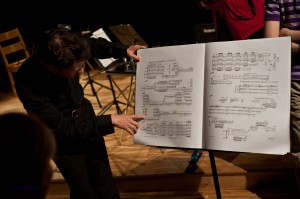 troubled contemporary world. The work portrays a voyage of the soul. The three stages of the voyage are Departure (fall from grace), Absence (spiritual annihilation) and Return (redemption)”. George Crumb is an American who composed this piece at the height of the war in Vietnam so the darkness of the music is understandable. During the intermission the quartet’s cellist Jeff Faragher walked the audience through some aspects of the composer’s score. It was a fascinating document that looked more like a piece of art than a musical score. In the second half of the program and Schubert’s “Death and the Maiden” the quartet returned to the readily recognizable musical vocabulary of the Romantic Era. The second movement of the quartet uses the theme from one of Schubert’s songs of the same name. Overall the mood of the evening may have been dark but the execution of the music was full of interesting musical techniques, sounds and explorations. The music was a far cry from polite string quartet wedding music and a planet away from your standard FM Classic Rock radio music. This was an evening of truly adventurous music.
troubled contemporary world. The work portrays a voyage of the soul. The three stages of the voyage are Departure (fall from grace), Absence (spiritual annihilation) and Return (redemption)”. George Crumb is an American who composed this piece at the height of the war in Vietnam so the darkness of the music is understandable. During the intermission the quartet’s cellist Jeff Faragher walked the audience through some aspects of the composer’s score. It was a fascinating document that looked more like a piece of art than a musical score. In the second half of the program and Schubert’s “Death and the Maiden” the quartet returned to the readily recognizable musical vocabulary of the Romantic Era. The second movement of the quartet uses the theme from one of Schubert’s songs of the same name. Overall the mood of the evening may have been dark but the execution of the music was full of interesting musical techniques, sounds and explorations. The music was a far cry from polite string quartet wedding music and a planet away from your standard FM Classic Rock radio music. This was an evening of truly adventurous music.




